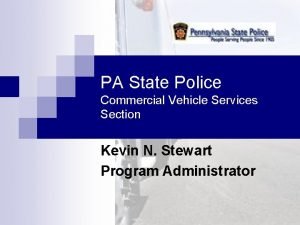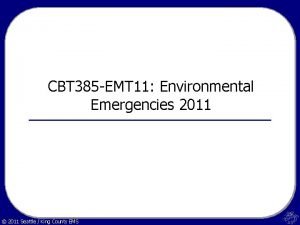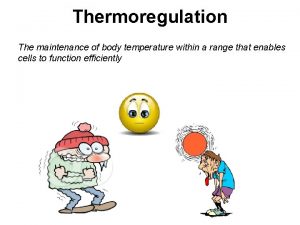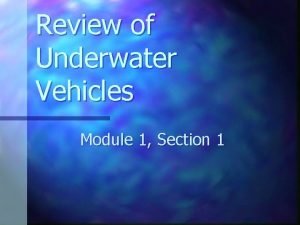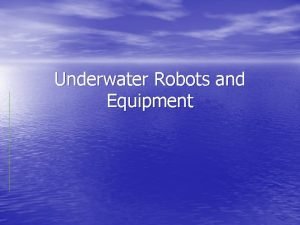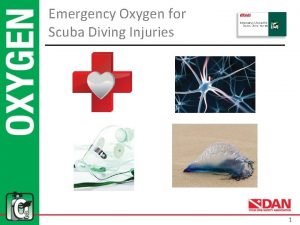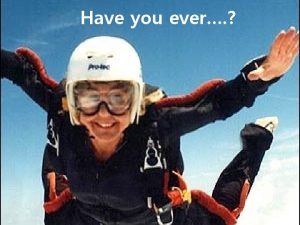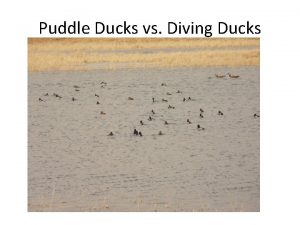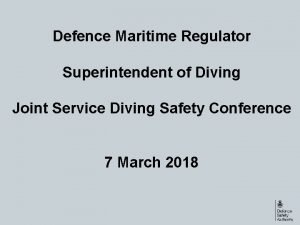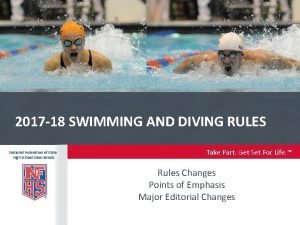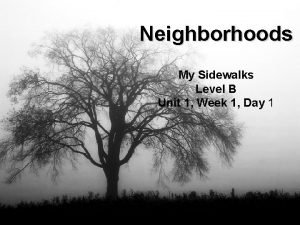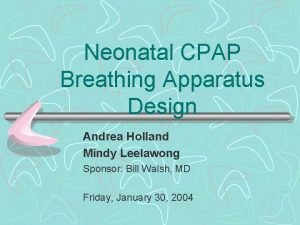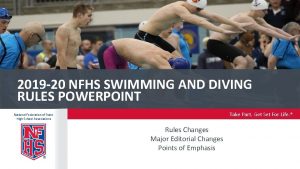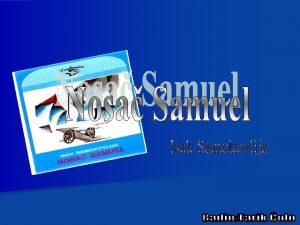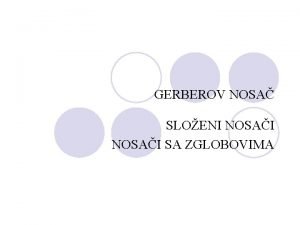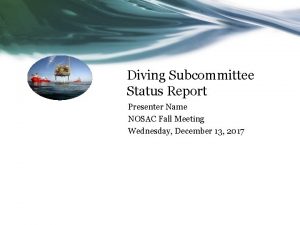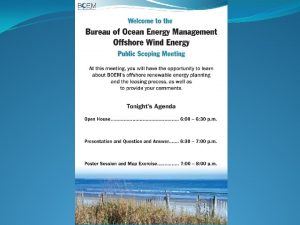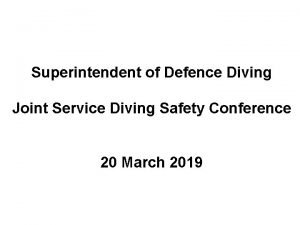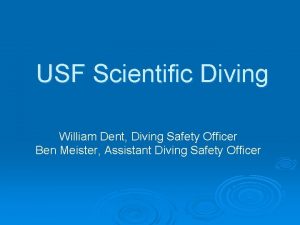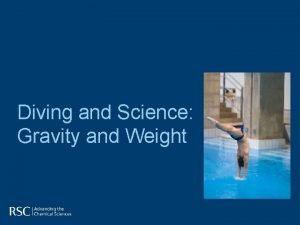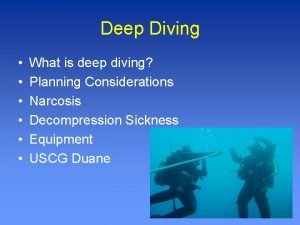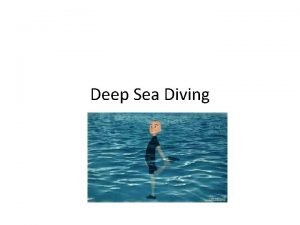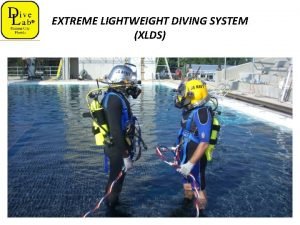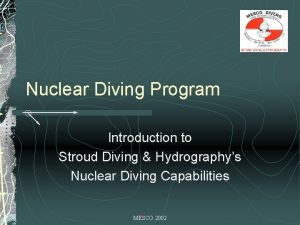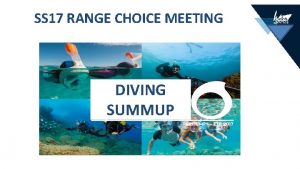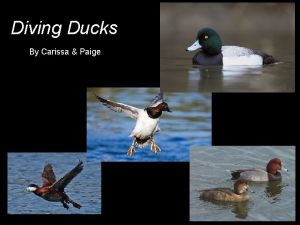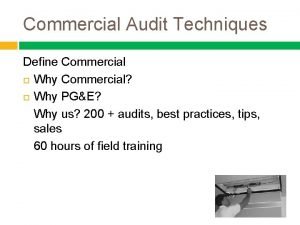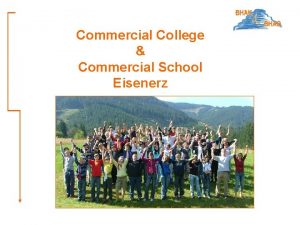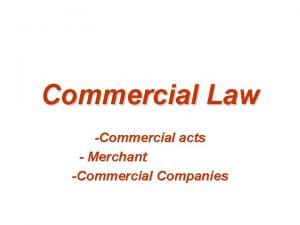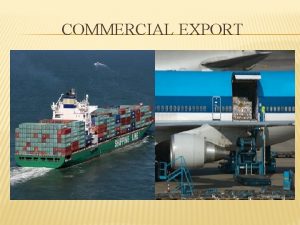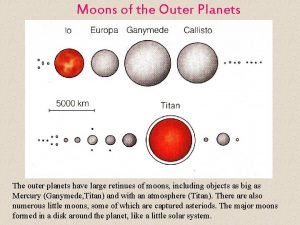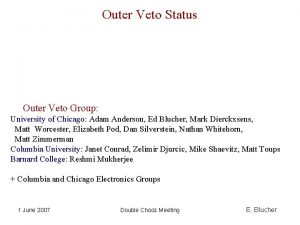NOSAC COMMERCIAL DIVING SAFETY ON THE OUTER CONTINENTAL






























- Slides: 30

NOSAC COMMERCIAL DIVING SAFETY ON THE OUTER CONTINENTAL SHELF SUBCOMMITTEE APRIL 17, 2014

SUB-COMMITTEE BACKGROUND A Subcommittee was formed with the appointment of: • Four (4) Co-Chairs • Two (2) from NOSAC – Mike Brown & Kelly Mc. Clelland • Two (2) from the Public – Phil Newsum & Louis Schaefer • Sub-committee Members • Over forty (40) members from the diving community, or who work in a related industry positions

TASK STATEMENT • Evaluate current state of Offshore Commercial Diving Operations on the OCS • Consider Past Commercial Diving Casualties • Improve Commercial Diving Operational Safety on the OCS • Develop Recommendations for the Coast Guard

BACKGROUND Technological advances have made oil exploration and production in previously inaccessible locations a reality. The search for oil has moved further offshore and into deeper water; new and unique challenges have been encountered. Diver services have been an integral part of this expansion and the diving industry has adapted as well.

ISSUE Current Commercial Diving, CFR 46 Part 197 is not consistent and current with Industry Best Practices.

SUB-COMMITTEE FOCUS GROUPS Availability of Standards Competency/Certification DP Vessel Diving Equipment – Hot Water Systems Hyperbaric Rescue Systems Live Boating (Including Manning Level Requirements) Maximum Depths Minimum Manning Levels Reserve Gas Supply Specific Diving Mode Procedures

ROLES OF FOCUS GROUPS • • Actively participate Respect diverse view points Complete assigned tasks within established time periods Maintain a written record (minutes) of all group meetings or conference calls • Provide updates as necessary • Familiarization with the NOSAC Commercial Diving Subcommittee Task Summary • Maintaining the focus of increased diving safety on the OCS when proposing revisions to 46 CFR Part 197

LOGISTICS Monthly teleconference § Co-chairs § Sub Committee Members (40+ Members) Bi-monthly teleconference

RECOMMENDATION: AVAILABILITY OF STANDARDS Finding - There are no standards for Commercial Diving Recommendation – Adoption of current: • IMCA International Code of Practice for Offshore Diving • Association of Diving Contractors International Consensus Standards

RECOMMENDATION: DP VESSEL DIVING Finding – Current CFR does not define nor address DP Diving Recommendation – Adopt the following: • Definition – Diving operations, surface supplied or saturation, conducted from a vessel operating in DP Mode; whenever there is any form of motive power in operation, e. g. , thrusters or propellers, which automatically maintains its position (fixed or a predetermined track) by means of thruster force. The DP system consists of a power system, a thruster system, a DP-control system with the redundancy built in to maintain or restore its function, e. g. DP 2 and DP 3. Diving Operations conducted from a DP 2 or DP 3 vessel should not be considered Live-Boating and may be performed at any time during the day or night provided a thorough hazard assessment has been performed. • Adopt the ADCI Consensus Standards, Section 8. 0 “Vessels and Floating Platforms for Diving Operations” in its entirety.

RECOMMENDATION: DIVER COMPETENCY / CERTIFICATION Finding - Current CFR does not define. Recommendation – Adopt the following: Diver Qualifications - Commercial Divers and Supervisors shall possess a recognized Commercial Diving qualification suitable for the scope of work they intend to perform unless they are engaged in a recognized training or advancement program. All personnel subject to hyperbaric exposure must possess a valid annual fitnessto-dive medical certificate.

RECOMMENDATION: DIVER COMPETENCY / CERTIFICATION (CONT’D) Training - A formal course of study for a Tender/Diver (entry-level) shall be completed at any accredited school, military school or equivalent whose curriculum at a minimum, conforms to current US Coast Guard recognized standards for commercial diver training. Diving personnel should follow a US Coast Guard industry recognized diver certification and training standard or matrix. In addition, other competencies or qualifications maybe required for some tasks; for example the use of specific tools or practices. The personnel included in diving personnel are: • Entry-Level Tender / Diver • Surface Supplied Air Diver • Surface Supplied Mixed-Gas Diver • Saturation Diver • Surface Supplied Air-Diving Supervisor • Surface Supplied Mixed-Gas Diving Supervisor • Saturation-Diving Supervisor • Life-Support Technician • Saturation Technician

RECOMMENDATION EQUIPMENT: HOT WATER SYSTEMS Finding - Current CFR does not define. Recommendation – Adopt the following. : • • • A suit receiving hot water must have a diver-operated bypass valve at the umbilical to divert excessively hot water. The source of a hot water system must be constructed so that the volume of controlledtemperature hot water supplied to the diver allows sufficient time for the diver to complete the environmental exposure portion of the dive. An adequate thermal support system must be in place to provide an amount of protection time equal to the bailout breathing gas supply time. A hot water system volume tank must be large enough to diffuse a sudden change in water temperature from reaching the diver. The water temperature delivery system must change slow enough to allow for evasive action should the water supply temperature become detrimental to the diver’s health. Hot water shall have audio and visual temperature alarms.

RECOMMENDATION: HYPERBARIC EVACUATION SYSTEM Finding - Current CFR does not define or address. Recommendation – Adopt the following: • There shall be a Hyperbaric Evacuation Facility on site when performing Saturation Diving Operations. • Adopt the IMCA Standard for Hyperbaric Evacuation Facility of Saturation Divers. • Shall have a transportable means (Flyway Package) to support the environmental and gas requirement of the Hyperbaric Evacuation Facility during decompression. • There shall be a written Emergency Hyperbaric Evacuation Plan on site.

RECOMMENDATION: LIVE BOATING INCLUDING MANNING REQUIREMENTS Finding – Current CFR is not consistent and current with Industry Best Practices. Recommendation – Adopt the following: Definition – Live Boating is a diving technique where a single surface supplied diver performs work underwater while the diver’s umbilical is being tended from the bow of a vessel which is manually operated by the vessel master and underway using its primary propulsion system. • During live boating operations, the Person in Charge shall be experienced in live boating operations and familiar with the scope of work, as well as the depth and duration of the dive; • The Person in Charge shall ensure that Diving is not conducted in seas that impede station-keeping ability of the vessel; • Live boating operations are not conducted (i) in other than daylight hours; or (ii) During periods of restricted visibility; • The primary propulsion system of the vessel is stopped before the Diver enters or exits the water; and • A boat is ready to be launched with the crew in the event of an emergency; and • The diving crew shall consist of a minimum of seven (7) diving qualified personnel. § One (1) Dive Supervisor § One (1) Diver § One (1) Standby Diver § Two (2) Tender / Divers § Two (2) personnel that are qualified Divers to assist with rescue boat operations.

RECOMMENDATION: LIVE BOATING INCLUDING MANNING REQUIREMENTS (CONT’D) • • Restricted visibility means any condition in which vessel navigational ability is restricted by fog, mist, falling snow, heavy rainstorms, sandstorms, lack of daylight, sea states that disturb the water surface and impede the ability to visually see the Diver’s bubble location, or any other similar causes. During live boating operations, the Diving Supervisor must be experienced and knowledgeable in live boating operations and the Diving Supervisor shall ensure that diving is not conducted at depths greater than 130 FSW; • Diving is not conducted in seas that impede Diver mobility or work function including water currents that impede Diver mobility; • In addition to the Tender / Diver, an additional mechanical device is required to ensure that the Diver's umbilical does not become entangled in the vessel's propeller(s) or primary propulsion system; A Standby Diver is ready, available and appropriately dressed while a Diver is in the water; Diving is not conducted with in-water decompression obligations; and

RECOMMENDATION: LIVE BOATING INCLUDING MANNING REQUIREMENTS (CONT’D) • • The Person-In-Charge is notified before a Diver enters or exits the water. During live boating operations, the minimum equipment shall consist of • Surface supplied diving equipment that is adequate for the depth of water; • A third diving umbilical connected to the manifold for emergency use; • Hard wired communications are utilized between the Diver and Dive Supervisor; • A diver worn reserve gas supply with a 5 minute breathing duration at depth; • A method of clear communications between the vessel master and the Dive Supervisor, • A method of clear communications between the Dive Supervisor and the Tender / Diver; • An emergency shutdown device for the main propulsion system; • A mechanical device to prevent dive umbilical entanglement in the primary propulsion system; and • A means to provide a stable platform for the Diver for in-water decompression for emergency purposes.

RECOMMENDATION MANNING LEVELS: SURFACE SUPPLIED AIR DIVING Finding - Current CFR is not consistent and current with Industry Best Practices Recommendation – Adopt the following: • Scuba Diving not recommended for Commercial Diving Operations. • SURFACE SUPPLIED-SHALLOW AIR DIVING – Shallow air diving to be conducted in depths from 0 – 35 feet. § No planned decompression. § Minimum manning levels § The minimum personal to conduct surface supplied-shallow air diving operations is five (5), with the following requirements; § One (1) Diving Supervisor § Must be a designated, qualified, Non-Diving Supervisor who is not required or allowed to dive, and has the qualifications of Surface Air Dive Supervisor; whose main responsibility is to ensure the safety of the Divers; § Two (2) Divers § Qualified for the type of work being conducted; § Two (2) Tender / Divers § Each Diver is to be continuously tended while in the water. § When a Diver is in a physically confined space another Diver is stationed at the underwater point of entry and is line tending the Diver. This would require one (1) additional Diver and on additional Tender / Diver to be on the job.

RECOMMENDATION MANNING LEVELS: SURFACE SUPPLIED DEEP AIR DIVING Finding - Current CFR is not consistent and current with Industry Best Practices Recommendation – Adopt the following: • • SURFACE SUPPLIED-DEEP AIR DIVING – Deep air diving to be conducted in depths from 34 – 165 feet. Minimum 1 double lock decompression chamber. § Minimum manning levels § The minimum personal to conduct surface supplied-deep air diving operations is five (5), with the following requirements; § One (1) Diving Supervisor § Must be a designated, qualified, Non-Diving Supervisor who is not required or allowed to dive, and has the qualifications of Surface Air Dive Supervisor; whose main responsibility is to ensure the safety of the Divers; § Two (2) Divers § Qualified for the type of work being conducted; § Two (2) Tender / Divers § Qualified to operate decompression chamber § Each Diver is to be continuously tended while in the water. § When a Diver is in a physically confined space another Diver is stationed at the underwater point of entry and is line tending the Diver. This would require one (1) additional Diver and one (1) additional Tender / Diver to be on the job.

RECOMMENDATION MANNING LEVELS: SURFACE SUPPLIED MIXED-GAS DIVING (HEO 2) Finding – Current CFR is not consistent and current with Industry Best Practices Recommendation – Adopt the following: • Minimum manning levels § The minimum personal to conduct Surface Supplied-Deep Air Diving Operations is six (6), with the following requirements; § One (1) Diving Supervisor § Must be a designated, qualified, Non-Diving Supervisor who is not required or allowed to dive, and has the qualifications of Surface Supplied Mixed-Gas Diver Supervisor; whose main responsibility is to ensure the safety of the Divers; § One (1) Mixed-Gas Manifold Operator (Rack Operator); § Must be a designated qualified Non-Diving, Gas Manifold Operator/Life Support Technician, who is not required or allowed to dive. Whose two main responsibilities are to insure that the proper gas mixtures are supplied to the. Diver and all in water decompression is properly completed; § Two (2) Divers § Qualified for the type of work being conducted; § Two (2) Tenders / Divers § Qualified to operate decompression chamber § Each diver is to be continuously tended while in the water. § When a Diver is in a physically confined space another Diver is stationed at the underwater point of entry and is line tending the Diver. This would require one (1) additional Diver and one (1) additional Tender / Diver to be on the job.

RECOMMENDATION MANNING LEVELS: SURFACE SUPPLIED MIXED-GAS DIVING (HEO 2) Finding – Current CFR is not consistent and current with Industry Best Practices Recommendation – Adopt the following: • Minimum manning levels § The minimum personal to conduct Surface Supplied-Deep Air Diving Operations is six (6), with the following requirements; § One (1) Diving Supervisor § Must be a designated, qualified, Non-Diving Supervisor who is not required or allowed to dive, and has the qualifications of Surface Supplied Mixed-Gas Diver Supervisor; whose main responsibility is to ensure the safety of the Divers; § One (1) Mixed-Gas manifold operator (Rack Operator); § Must be a designated qualified Non-Diving, Gas Manifold Operator/Life Support Technician, who is not required or allowed to dive. Whose two main responsibilities are to insure that the proper gas mixtures are supplied to the. Diver and all in water decompression is properly completed; § Two (2) Divers § Qualified for the type of work being conducted; § Two (2) Tenders / Divers § Qualified to operate decompression chamber § Each Diver is to be continuously tended while in the water. § When a Diver is in a physically confined space another Diver is stationed at the underwater point of entry and is line tending the Diver. This would require one (1) additional Diver and one (1) additional Tender / Diver to be on the job.

RECOMMENDATION MANNING LEVELS: SURFACE SUPPLIED NITROGEN/OXYGEN MIXED-GAS DIVING Finding – Current CFR does not contain Surface Supplied Nitrogen/Oxygen Mixed-Gas Diving Guidelines Recommendation – Adopt the following: • Minimum manning levels § The minimum personal to conduct Surface Supplied-Deep Air Diving operations is five (5), with the following requirements; § One (1) Diving Supervisor § Must be a designated, qualified, Non-Diving Supervisor who is not required or allowed to dive, and has the qualifications of Surface Supplied Mixed-Gas Diver Supervisor; whose main responsibility is to ensure the safety of the Divers; § Two (2) Divers § Qualified for the type of work being conducted; § Two (2) Tenders / Divers § Qualified to operate decompression chamber § Each Diver is to be continuously tended while in the water. § When a Diver is in a physically confined space another Diver is stationed at the underwater point of entry and is line tending the Diver. This would require one (1) additional Diver and one (1) additional Tender Diver to be on the job.

RECOMMENDATION: MAXIMUM DEPTH Finding – Current CFR is not consistent and current with Industry Best Practices Recommendation - Adopt the following: Scuba Diving (Not Recommended for Commercial Diving Operations) § 30 FSW (It should be restricted to 30 FSW for minor shallow inspection applications. ) Surface Supplied Air Diving § 165 FSW Surface Supplied Mixed-Gas (He. O₂) Diving § 250 FSW (Requirement for an open bottom bell with onboard emergency gas for all He. O₂ diving applications) Surface Supplied NITROX (N₂ O₂) Diving § Maximum 1. 3 PPO₂ Saturation Diving § No limits

RECOMMENDATION: RESERVED GAS SUPPLY (BAILOUT BOTTLE OR RGS) Finding – Current CFR is not consistent and current with Industry Best Practices and does not require RGS in less than 130 FSW. Recommendation - Adopt the following: • Require Reserved Gas Supply on all dives. • Must be able to supply a minimum of five (5) minutes breathing supply to the Diver at depth. • RGS must contain the same gas as the Divers Bottom Mix.

RECOMMENDATION: SPECIFIC DIVING MODE GUIDELINES Finding – Current CFR does not contain Saturation Diving Guidelines. Recommendation - Add Saturation Diving Guidelines: Recommend CFR should include specific requirements for Saturation Diving. Propose draft text on Saturation Diving for inclusion in the CFR, as follows: The Diving Supervisor shall insure that— § When Saturation Diving is conducted, a suitable living habitat is present for Divers to live. The living habitat shall consist of shower, sleeping, eating and the toilet receptacle with a raised vented seat to ensure a seal cannot be created. § A closed bell with Transfer Under Pressure (TUP) capacity is available. § Each bell shall have two forms of retrieval in the event of a parted lifting or malfunctioning apparatus. § A hyperbaric rescue facility, Self Propelled Hyperbaric Life Boat (SPHLB), or Hyperbaric Rescue Chamber (HRC), shall be available which is capable of evacuating the Divers and attaining the maximum storage depth of the Saturation Dive. Additionally, dive supervisors must ensure an evacuation plan is in place to take into account available recompression facilities to safely ascend divers following any incident.

RECOMMENDATION: SPECIFIC DIVING MODE GUIDELINES (CONT’D) The Diving Supervisor shall insure that (Cont’d) — § A Standby Diver is available when the closed bell leaves the dive location until the Divers have returned to the Saturation System. § A qualified dive team member shall be available at the dive location to assist in the recovery of the closed bell or its occupants. § Follow the established Dive Plan Procedure for obtaining medical support in the event of an accident, either for a diving or non-diving related incident. Ensure a DMT / EMT is present and available. § Validate the Dive Plan for sufficient Breathing Mixtures, Supplies, and Equipment. § Verify that all personnel meet the necessary qualification to perform the assigned task.

RECOMMENDATION: SPECIFIC DIVING MODE GUIDELINES (CONT’D) The Diving Supervisor shall insure that (Cont’d) — § A Standby Diver is available when the closed bell leaves the dive location until the Divers have returned to the Saturation Facility. There should be a ‘Dive Intervention Plan’ in place. There shall be a suitable supply of treatment gas available for each individual storage depth of the Saturation System. § Each diving operation shall have a primary and secondary breathing gas supply meeting the proposed established requirements. § The lockout duration from seal to seal shall take into consideration fatigue, physiological effects, including type of work being undertaken.

RECOMMENDATION: SPECIFIC DIVING MODE GUIDELINES (CONT’D) Recommend the following for revisions for Specific Diving Mode Guidelines in future phases. • Scuba – is not recommended for Offshore Commercial Diving • Surface Supplied Air Diving • Surface Supplied Mix-Gas (He. O₂) Diving • Live Boating • Add a section for NITROX Diving

RECOMMENDATION Additional Recommendation: • Reconvene Sub-Committee to further evaluate other areas not addressed in Phase I. • Develop a way to measure accountability of member’s participation in future Sub. Committee Focus Groups.

QUESTIONS?
 What causes tectonic plates to move? *
What causes tectonic plates to move? * Divergent plate boundary
Divergent plate boundary Non commercial foodservice
Non commercial foodservice Commercial aviation safety team
Commercial aviation safety team Pa state police commercial vehicle safety division
Pa state police commercial vehicle safety division Three pigs entered a race around a track
Three pigs entered a race around a track Emt environmental
Emt environmental Mammalian diving reflex
Mammalian diving reflex Atmospheric diving suit
Atmospheric diving suit Atmospheric suits
Atmospheric suits Scuba delivery system components
Scuba delivery system components Diving into mastery
Diving into mastery Have you ever been bungee jumping
Have you ever been bungee jumping Air mixed gas surface supplied diving new orleans
Air mixed gas surface supplied diving new orleans Puddle duck kennels
Puddle duck kennels Diveinm
Diveinm Nfhs swimming and diving rules book
Nfhs swimming and diving rules book My sidewalks level b unit 2 week 3 comprehension test
My sidewalks level b unit 2 week 3 comprehension test Andrea holland diving
Andrea holland diving Kristina vukaj
Kristina vukaj Nfhs diving dd table
Nfhs diving dd table Diving terminology
Diving terminology Nosac samuel kratak sadržaj
Nosac samuel kratak sadržaj Nosac kofera u hotelu
Nosac kofera u hotelu Recepcijske usluge
Recepcijske usluge Gerberov nosac
Gerberov nosac Sự nuôi và dạy con của hổ
Sự nuôi và dạy con của hổ điện thế nghỉ
điện thế nghỉ Nguyên nhân của sự mỏi cơ sinh 8
Nguyên nhân của sự mỏi cơ sinh 8 Một số thể thơ truyền thống
Một số thể thơ truyền thống Trời xanh đây là của chúng ta thể thơ
Trời xanh đây là của chúng ta thể thơ




